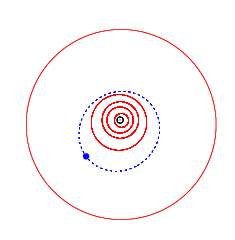 Orbits of Sandage (blue), the inner planets (red) and Jupiter (outermost) | |
| Discovery [1] | |
|---|---|
| Discovered by | E. F. Helin |
| Discovery site | Palomar Obs. |
| Discovery date | 9 January 1992 |
| Designations | |
| (9963) Sandage | |
Named after | Allan Sandage (American astronomer) [2] |
| 1992 AN ·1976 NH 1989 CK6 | |
| main-belt · Phocaea [3] [4] | |
| Orbital characteristics [1] | |
| Epoch 4 September 2017 (JD 2458000.5) | |
| Uncertainty parameter 0 | |
| Observation arc | 28.13 yr (10,276 days) |
| Aphelion | 2.9982 AU |
| Perihelion | 1.6833 AU |
| 2.3408 AU | |
| Eccentricity | 0.2809 |
| 3.58 yr (1,308 days) | |
| 132.58° | |
| 0° 16m 30.72s / day | |
| Inclination | 23.461° |
| 116.97° | |
| 241.14° | |
| Physical characteristics | |
| Dimensions | 5.45 km (calculated) [3] 6.371±0.174 km [5] [6] |
| 4.6502±0.0008 h [7] 4.65053±0.00013 h [8] | |
| 0.158±0.025 [5] [6] 0.23 (assumed) [3] | |
| S [3] | |
| 12.9 [1] ·12.95±0.25 [9] ·13.080±0.002(R) [7] ·13.53 [3] ·13.6 [5] | |
9963 Sandage, provisional designation 1992 AN, is a stony Phocaea asteroid from the inner regions of the asteroid belt, approximately 6 kilometers in diameter.
Contents
- Orbit and classification
- Physical characteristics
- Rotation period
- Diameter and albedo
- Naming
- References
- External links
It was discovered by American astronomer Eleanor Helin at the Palomar Observatory in California on 9 January 1992, and later named after American astronomer Allan Sandage. [2] [10]